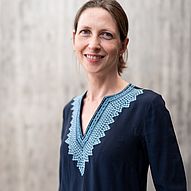
Group Info
We are recruiting!
We are currently recruitig students to join our group as PhD students or postdocs, as well as for Master's projects. We have projects in the area of electro and photocatalysis, as well as artificial metalloenzyme design. For more information see our 'Research' page, or contact us.
Interested canndidates should send a CV and cover letter to Prof. Hess.
Contact Information
Research labs: 23.2.22, 23.22.23
Phone: 0941 943 4904
Current Group Members

Kerstin Rickmeyer
Kerstin.Rickmeyer[]chemie.uni-regensburg.de
Research: My project focuses on small molecule activation, in particular the reduction of the green-house gas CO2. Toward this end, I investigated the performance of Co(II)- and Fe(II)-Mabiq complexes in electrocatalytic CO2 reduction. Furthermore, we are currently studying photocatalytic CO2 reduction by mono- and bimetallic Fe(II)-Mabiq complexes with respect to the influence of the second binding site on the performance and mechanism.

Matthias Huber
mat.huber[]tum.de
Research: My research focuses on the study of bimetallic Mabiq complexes. The Mabiq ligand offers a unique second binding site which allows us to further tune electro- and photochemical properties of its complexes. In light of this, I am exploring the influence of a Cu(I) center on photochemical properties of Fe-Mabiq complexes. By introducing different secondary ligands e.g., xantphos, second sphere effects can help to increase efficiency in photochemical reactions.
In another project (together with Prof. Hannah Shafaat and Dr. Olaf Rüdiger) I am incorporating metal-Mabiq complexes into Ni-rubredoxin to study factors that affect H2 evolution by the enzyme.

Sayonika Chakraborty
Sayonika.Chakraborty@chemie.uni-regensburg.de
Research: Carbonyl groups are very common in several industrial relevant chemicals. However, traditionally many synthetic routes use harsh reaction conditions as well as rare and expensive 4d & 5d metals. My project aim is to utilise our established Metal-Mabiq complexes employing earth-abundant metals to valorise CO—obtained from CO2 reduction—by adding it to organic substrates. By harnessing the photoactive properties of Metal Mabiq complexes, in particular those of Fe and Co-Mabiq complexes, I am attempting to develop a more sustainable technique for the synthetic transformations of CO into more value-added products.

Philippe Ibouanga
philippe.ibouanga[]tum.de
Research: The goal of my research is to generate artificial enzymes for small molecule activation. On one hand I combine molecular biology, biochemistry and organic synthesis in the design of proteins that can bind our Mabiq complexes. On the other hand, I study the use of metal-Mabiq complexes as catalysts for CO2 valorisation.

